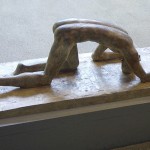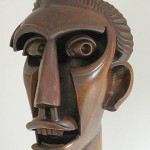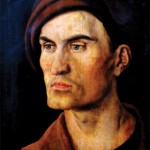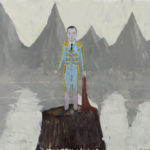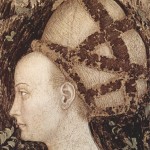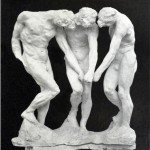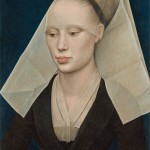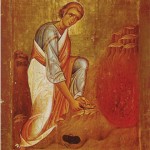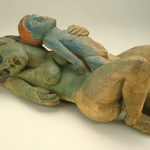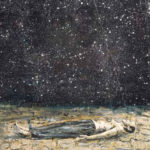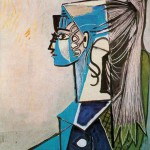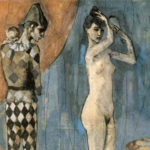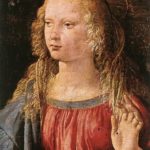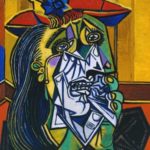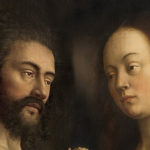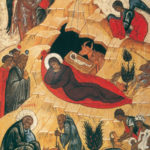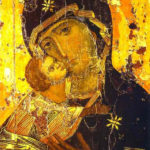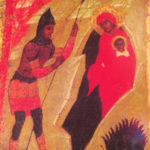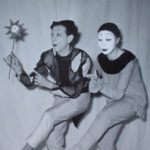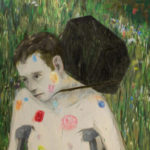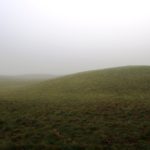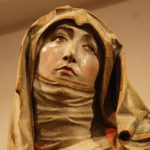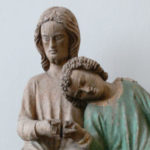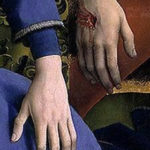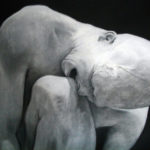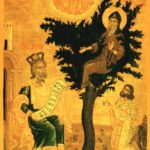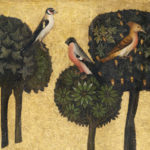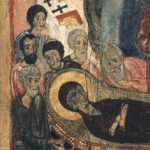I might have started This is Why I Came differently had I remembered this image.
“Six Lines of Flight: Shifting Geographies in Contemporary Art” was an edgy show put on by SFMOMA in 2012 and I liked it. The exhibit explored art works from six “burgeoning art scenes” in six cities where growth of the local art had been rapid since the mid-1990’s: Beirut, Cali, Cluj-Napoca, Ho Chi Minh City, San Francisco and Tangier.
I thought, seeing this image again, this untitled photomontage by an anonymous photographer in Fez, Morocco, yes! a feminist take on the creation story in Genesis where we find the well-known words, And God said, “Let us make man in our image…”
It was a jolt and refreshing at first to picture God this way. The drop earrings, the wavy hair and delicate wrists. A great push-back from the old man in flowing robes with his long beard. But that pleasure, that push-back, didn’t last long because I’ve never thought of God as an old man with a flowing beard anyway. Or even as narrowly gendered, male or female. I write “him” and “his” out of convention and simplicity knowing that it is as ill-fitting as “her” or “hers.” Actually to write the word “God” feels to me like violation of whatever the reality is I’m trying to convey, a deeply unacceptable shrinking of that Unnamable to something small, weird and distorted.
Yet I liked this image for creation, not sure why. Was it something precisely in the smallness? The soft v-neck sweater, the trimmed fingernails?
In time I realized it was the gaze between the two figures that I liked.Uninterrupted, curious, the attentive gaze that seeks the other, recognizes something profoundly familiar in the other. A gaze that could possibly generate all that is. Could house all that is.
The exhibition catalogue explains that “the artists in this exhibition have cultivated hospitable environments for critical thinking…” and I wondered, “What is the ‘hospitable environment’ for thinking about the Bible?”
There are many approaches– historic, anthropological, archaeological, etc. all good. But I came to decide that the most hospitable environment for thinking about the Bible is wonder. That all the varied books in the Bible, poetry, history, law, and all the verses in those books would never have been written without wonder. And I came to think of the Bible as a long, complex, many-sided dream. Not “dream” meaning un-true, but “dream” in the sense that mathematics is a dream, and physics, the law and medicine, fashion, architecture, music, painting and astronomy, theology, once called “the queen of the sciences” are all dreams, are each is a shared, sustained dream.
My guess is that each of these disciplines started with wonder. And it seems that each continues most authentically when still propelled by wonder.
Wonder is wanting to understand something in its own right. Its markings are humility, eagerness, modesty, discipline and gratitude.
This untitled photomontage seemed and seems an apt image for the Genesis creation story because the two figures look at each other with wonder. And we see in their expressions wonder’s prize, which is much more than the accumulation of new information. It’s what Archimedes must have felt when he shrieked “Eureka!” The prize for wonder is joy.
Note:
Photomontage by an anonymous photographer, Fez, Morocco, n.d. Collection AIF/Yto Barrada (A. Tazi), courtesy of the Arab Image Foundation.




